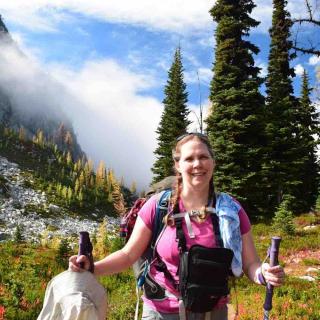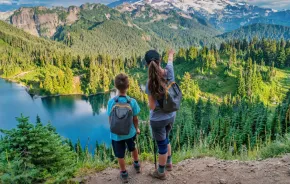
Photo:
Watch the Milky Way at Mount Rainier. Photo: Brie Hawkins
One summer while camping at Mount Rainier National Park, my two children and I went up to Paradise to catch the sunset and look at the stars. We were pleasantly surprised to find park rangers and volunteers setting up for an evening of stargazing with telescopes. We hung around until almost midnight, taking turns with other park visitors looking through large telescopes at distant stars, planets and even other galaxies. My kids were entranced.
There are plenty of stellar opportunities around Puget Sound to learn about the night sky during the summer. And one of the peak stargazing events of the year is approaching: The Perseid meteor shower, which you can view from Puget Sound urban areas, will peak Aug. 12–13, 2025. The Perseids produce the most star trails after midnight, when the sky is darker.
The Perseids happen when Earth travels through the debris of Comet Swift-Tuttle. Families can also enjoy watching for the International Space Station as it passes overhead. And the aurora borealis sometimes makes an appearance — keep track on spaceweather.com for possible magnetic storms.

Stargazing in Seattle
Dark and cloudless skies are required for stargazing, which makes Seattle and other urban areas less than ideal. But for families just starting out, there are still some urban spots dark enough to lay your blanket out and see the night sky.
Alice Enevoldsen, a local expert on astronomy and education, recommends several different sites in the city for urban stargazing, including Myrtle Reservoir, Lincoln Park and Solstice Park in West Seattle. Green Lake is also a popular stargazing site, as it is open until 11:30 p.m.
The Seattle Astronomical Society periodically hosts star parties at various locations, including Paramount School Park, Snoqualmie Point Park, Bonney Lake and Covington City Park. Members of the society bring telescopes for the general public to use and enjoy sharing astronomical facts with people of all ages.
In the South Sound, the Tacoma Astronomical Society also hosts public viewing sessions at Pierce College. If you’re headed to the Tri-Cities, the Tri-City Astronomy Club hosts public events, including lunar viewing parties with astronomers.
Brie Hawkins, a local weather enthusiast and photographer, recommends Lighthouse Park in Mukilteo for urban stargazing. Some of her favorite spots away from the city include the Diablo Lake and Washington Pass overlooks along Highway 20 in the North Cascades. These places are open at night and have toilets available. You can find camping at Newhalem or Colonial Creek near Diablo Lake, or Klipchuck or Early Winters campgrounds near Washington Pass.

Starry camping and backpacking
Getting farther away from the city, of course, will earn you more Perseids action. One of Enevoldsen’s favorite spots is the boat dock at Lake Kachess along I-90, and Staircase Campground in Olympic National Park. (If you’re not staying overnight at the campground, talk to the ranger to get permission to be there.)
For families who are looking for more adventure, consider attending an event at one of our national parks or monuments. The Olympia Astronomical Society (OAS) occasionally hosts star parties and night hikes at Hurricane Ridge. Check the OAS website for future events, including its biannual four-night event, Camp Delany Star Party.
The Mount St. Helens Institute sponsors occasional sky and star parties, with one planned for July 26, 2025.

Families who enjoy backpacking will find even more places to be away from city lights. Child-friendly backpacking trips with open skies include Shadow Lake at Mount Rainier and Lake Ann in the North Cascades.
Other popular camping and photography areas include Tipsoo Lake near Mount Rainier, Slate Peak out of Mazama, Salmon La Sac and the surrounding camping areas and Sun Lakes – Dry Falls State Park in Central Washington.
Stargazing gear and tips
More stargazing spots and resources for curious families
|
Editor’s note: This article was originally published several years ago and updated most recently on July 1, 2025, by ParentMap’s family fun editor, Meredith Charaba, with additional details for watching the 2025 Perseids meteor shower.











